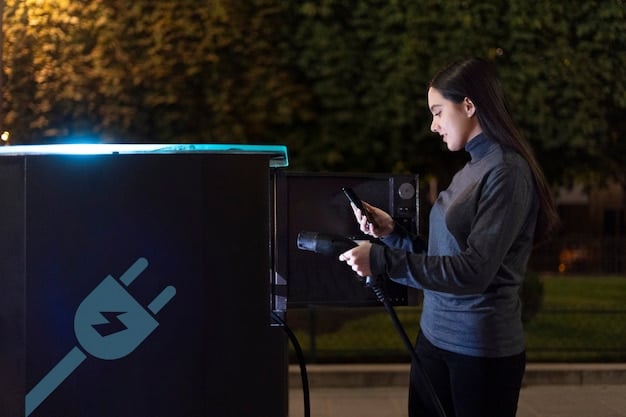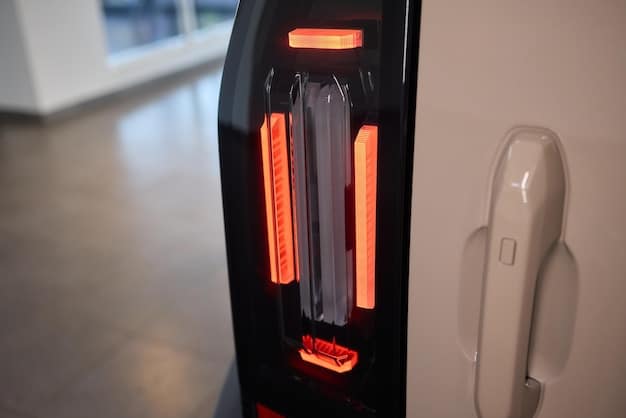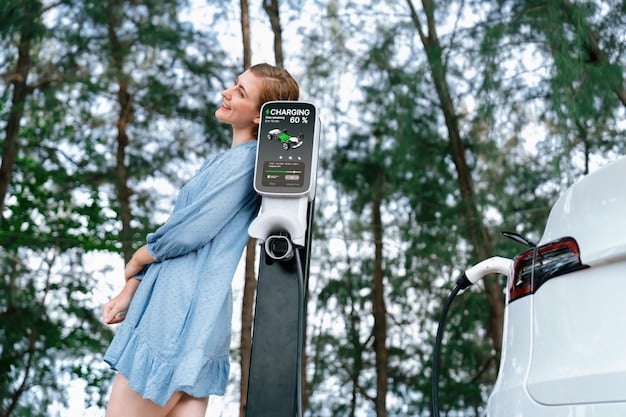The Future of EV Charging: Wireless & Fast-Charging Technologies

Advertisements
The future of electric vehicle (EV) charging is being revolutionized by wireless and fast-charging technologies, offering enhanced convenience, efficiency, and accessibility for EV owners.
The adoption of electric vehicles (EVs) is rapidly increasing, and with it, the demand for more efficient and convenient charging solutions. The future of electric vehicle charging: exploring wireless and fast-charging technologies, is poised to transform the way we power our EVs, making the experience seamless and user-friendly.
Advertisements
Understanding Wireless EV Charging Technology
Wireless EV charging, also known as inductive charging, is a technology that allows electric vehicles to charge without the need for physical cables. This is done through the transfer of energy via electromagnetic fields, offering a more convenient and user-friendly charging experience.
How Wireless Charging Works
Wireless charging systems typically consist of two main components: a charging pad or coil embedded in the ground or a wall, and a receiving coil built into the electric vehicle. When the EV is parked over the charging pad, an alternating current is passed through the transmitting coil, creating a magnetic field. This magnetic field induces an electric current in the receiving coil of the EV, which then charges the battery.
Advertisements
Benefits of Wireless EV Charging
Wireless charging offers several key benefits:
- Convenience: Eliminates the need to plug in and unplug cables, making charging simpler and more convenient.
- Aesthetics: Can be integrated into various environments, such as parking spaces and garages, without the clutter of cables.
- Automation: Supports autonomous vehicles by enabling automatic charging without human intervention.

Wireless charging is not just a convenience; it’s a step towards a more automated and integrated transportation ecosystem. As technology improves, we can expect to see wider adoption in both public and private settings.
Exploring Fast-Charging Technologies
Fast-charging technologies are designed to significantly reduce the amount of time it takes to charge an EV, making electric vehicles a more practical option for long-distance travel and daily commutes.
DC Fast Charging (DCFC)
DC Fast Charging, also known as Level 3 charging, is the quickest way to charge an EV. It uses direct current (DC) to deliver high power directly to the vehicle’s battery, bypassing the onboard charger.
Charging Standards: CHAdeMO and CCS
There are primarily two competing standards for DC fast charging:
- CHAdeMO: Developed in Japan, primarily used by Nissan and Mitsubishi.
- CCS (Combined Charging System): The dominant standard in North America and Europe, supported by most major automakers.
The Rise of 800V Charging Systems
Newer EVs, such as the Hyundai Ioniq 5 and Porsche Taycan, are equipped with 800V charging systems. These systems allow for even faster charging speeds compared to traditional 400V systems.
DC fast charging stations are becoming increasingly prevalent along major highways and in urban areas, providing EV drivers with the ability to quickly replenish their batteries while on the go.

The Impact of Grid Infrastructure on EV Charging
The expansion of EV charging infrastructure requires significant upgrades to the electrical grid to handle the increased demand. This includes investments in grid capacity, smart grid technologies, and renewable energy sources.
Smart Grids and Load Management
Smart grids use advanced sensors, communication networks, and control systems to monitor and manage the flow of electricity. This allows for better load balancing and can help prevent overloading the grid during peak charging times.
Renewable Energy Integration
Combining EV charging with renewable energy sources, such as solar and wind power, can further reduce the environmental impact of electric vehicles. Solar-powered charging stations are becoming increasingly common, providing a sustainable and cost-effective charging solution.
Upgrading the grid to support EV charging is a complex but essential task. It will require collaboration between utilities, governments, and the private sector to ensure a reliable and sustainable charging infrastructure.
Innovations in Battery Technology for Faster Charging
Advancements in battery technology are playing a crucial role in improving EV charging speeds. New battery chemistries and designs are enabling faster charging rates and higher energy densities.
Solid-State Batteries
Solid-state batteries are a promising technology that could revolutionize EV charging. They offer several advantages over traditional lithium-ion batteries, including:
- Faster Charging: Solid-state batteries can potentially charge much faster than lithium-ion batteries.
- Higher Energy Density: They can store more energy in a smaller volume, increasing the range of EVs.
- Improved Safety: Solid-state batteries are less prone to overheating and fires.
Silicon Anode Batteries
Silicon anode batteries are another emerging technology that can significantly improve charging speeds. Silicon has a much higher energy density than graphite, the material typically used in lithium-ion battery anodes.
Innovations in battery technology are continuously pushing the boundaries of what’s possible in EV charging, paving the way for faster, safer, and more efficient electric vehicles.
The Role of Standardization in EV Charging
Standardization is critical for ensuring interoperability and compatibility across different EV charging systems. Standardized charging connectors, communication protocols, and payment systems make it easier for EV drivers to charge their vehicles regardless of the charging station or location.
Standardizing Wireless Charging
Efforts are underway to standardize wireless charging technologies to ensure that EVs can charge seamlessly at any compatible charging station. Organizations like the Society of Automotive Engineers (SAE) are developing standards for wireless charging systems.
Harmonizing Fast-Charging Protocols
Harmonizing fast-charging protocols, such as CCS and CHAdeMO, would simplify the charging experience for EV drivers and promote wider adoption of electric vehicles. However, this can be hard to achieve as different organizations will want to support different systems.
Standardization efforts are essential for creating a cohesive and user-friendly EV charging ecosystem. This will help to build consumer confidence and accelerate the transition to electric mobility.
Future Trends and Predictions in EV Charging
The future of EV charging is expected to be shaped by several key trends, including increased adoption of wireless charging, further advancements in fast-charging technologies, and the integration of charging infrastructure with smart city initiatives.
Ubiquitous Wireless Charging
Wireless charging is expected to become more widespread in the coming years, with charging pads embedded in parking spaces, roadways, and even public transportation hubs. This will enable EVs to charge on the go, further enhancing convenience and eliminating range anxiety.
Ultra-Fast Charging Networks
The development of ultra-fast charging networks capable of delivering charging speeds of 350kW or higher will significantly reduce charging times. These networks will make it possible to add hundreds of miles of range in just a few minutes.
The evolution of EV charging is accelerating, driven by technological innovation and increasing demand for electric mobility. The future promises a seamless, efficient, and sustainable charging experience for EV drivers.
| Key Point | Brief Description |
|---|---|
| ⚡ Wireless Charging | Convenient cable-free charging via electromagnetic fields. |
| ⏱️ DC Fast Charging | Reduces charging time significantly using direct current. |
| 🔋 Battery Innovations | Solid-state and silicon anode batteries for faster charging. |
| 🌐 Grid Upgrades | Smart grids and renewable integration for sustainable charging. |
Frequently Asked Questions
▼
Wireless EV charging uses electromagnetic fields to transfer energy from a charging pad to a receiver in the vehicle, eliminating the need for cables.
▼
DC fast charging, or Level 3 charging, uses direct current to quickly charge an EV’s battery, significantly reducing charging times compared to Level 1 or 2 charging.
▼
Solid-state batteries are a new type of battery that replaces the liquid electrolyte with a solid material, offering faster charging, higher energy density, and improved safety.
▼
Grid infrastructure upgrades are essential to handle the increased demand from EV charging, ensuring a reliable and sustainable electricity supply through smart grids and renewable energy integration.
▼
Standardization ensures interoperability and compatibility across different EV charging systems, making it easier for EV drivers to charge their vehicles regardless of the station or location.
Conclusion
As we look to the future, the integration of wireless and fast-charging technologies promises to revolutionize the EV charging experience, making it more seamless, efficient, and accessible. These advancements, coupled with grid infrastructure upgrades and battery innovations, will pave the way for wider adoption of electric vehicles and a more sustainable transportation ecosystem.